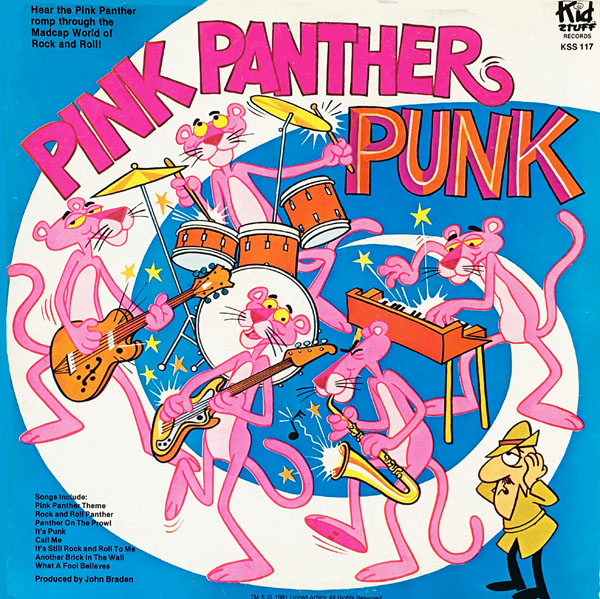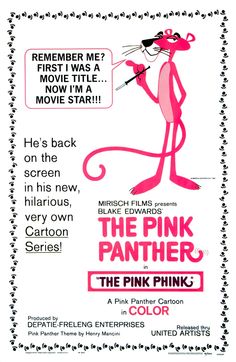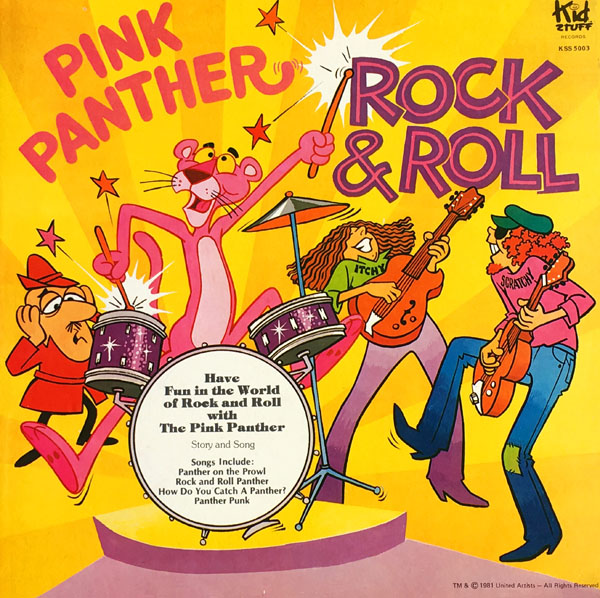Four albums from the Florida-based Kid Stuff label somehow star the Blake Edwards/DePatie-Freleng character in musical stories without his speaking a word.

PINK PANTHER PUNK
Kid Stuff Records KSS-117 (12” 33 1/3 RPM / Stereo / 1981 / 26 minutes)
Pop Songs: “Another Brick in the Wall” by Roger Waters; “It’s Still Rock and Roll to Me” by Billy Joel; “What a Fool Believes” by Kenny Loggins, Michael McDonald; “Call Me” by Giorgio Moroder, Debbie Harry.
Original Songs: “Panther on the Prowl,” “Rock and Roll Panther” by John Braden.
Instrumental: Theme from “The Pink Panther” by Henry Mancini.
Kid Stuff was an odd little record company that set up shop in the Washington Federal building in Hollywood, Florida. It was across the street from the Hollywood Mall, where TV’s Supermarket Sweep was taped in the ‘60s and Adam Walsh was abducted in the ‘80s.
 Kid Stuff’s first releases were adaptations of public domain stories and local children’s plays, including those of actor/director Ivan Kivitt of Miami’s Merry-Go-Round Playhouse. The earliest records, which were particularly abundant in area record stores, had very humble, rough artwork and graphics.
Kid Stuff’s first releases were adaptations of public domain stories and local children’s plays, including those of actor/director Ivan Kivitt of Miami’s Merry-Go-Round Playhouse. The earliest records, which were particularly abundant in area record stores, had very humble, rough artwork and graphics.
As Disneyland Records entered its second golden age with Mickey Mouse Disco and a line of albums and read-alongs featuring Disney and other licensed characters, and Peter Pan hit gold with Irwin the Disco Duck, their Power comic book character line and various covers of current pop hits, Kid Stuff slowly gained momentum in a similar way.
Strawberry Shortcake was an early success. The cover art in the series literally transitions from magic marker to slick on-model art as the label began its climb. Kid Stuff aggressively snapped up the properties Disney hadn’t acquired and released records at a lightning pace. By and large, the audio on each disc shows the effect of breakneck production and limited funds.
John Braden, also Florida-based, wrote and produced most of the early licensed records, including The Pink Panther titles. As Kid Stuff grew more prestigious, so did their stable of creative talent. The Care Bears series was produced by Mark Volman and Howard Kaylan of The Turtles. Paddington records were produced in New York by Arthur Shimkin, founder of Golden Records. A few albums were actual soundtracks but most were still being made in South Florida.
 The Pink Panther LPs came in the wake of Strawberry Shortcake and followed the identical format—a rock and roll album, a country platter, etc. and helped launch Kid Stuff into competition alongside Disney, Peter Pan and Sesame Street on big box store shelves.
The Pink Panther LPs came in the wake of Strawberry Shortcake and followed the identical format—a rock and roll album, a country platter, etc. and helped launch Kid Stuff into competition alongside Disney, Peter Pan and Sesame Street on big box store shelves.
The Pink Panther Punk album is the only one to feature cover versions of actual hit songs. The slim plot is a series of present-time radio broadcasts involving a band called “The Pink Punks” and their new drummer, who turns out to be the Panther.
This is the only album that suggests the Panther might speak, other than the Henry Mancini music signaling his arrival. An interviewer (who in ‘70s tradition, is a “Baba Wawa” personality based on Gilda Radner’s Barbara Walters impression on NBC’s Saturday Night) asks him about criticism of his wardrobe.
Ultimately, his bandmates respond with the opening words to Billy Joel’s “It’s Still Rock and Roll to Me” (“What’s the matter with the clothes I’m wearing…”) The band members are named Itchy and Scratchy, by the way, eight years before The Simpsons coincidentally introduced its show-within-a-show characters with the same names.
On DePatie-Freleng’s Saturday morning Pink Panther TV shows, there was a running storyline in the interstitial segments between the cartoons in which Inspector Clouseau and his assistant, Deux-Deux, pursued the Panther for no apparent reason except mild hijinks. This is the case on all four of these Kid Stuff albums, with The Inspector (with his customarily outrageous French accent) and Deux-Deux (with a now-un-PC Hispanic accent) are played by two uncredited actors in place of One Day at a Time’s Pat Harrington, Jr., who voiced both.

PINK PANTHER ROCK & ROLL
Kid Stuff Records KSS-5003 (12” 33 1/3 RPM / Stereo / 1981 / 29 minutes)
Songs: “Panther on the Prowl,” “Rock and Roll Panther,” “How Do You Catch a Panther?” “Panther Punk” by John Braden.
Instrumental: “Theme from The Pink Panther” by Henry Mancini.
This is essentially a reworking of Pink Panther Punk without the expensive pop songs. The story is now about the band before the Panther became their drummer. The Inspector disguises himself as “Rona Ripoff” this time around but does the “Baba Wawa” voice instead of a Rona Barrett impression.
The Inspector does indeed nab the Panther, but public outcry convinces him to reverse his decision—if the Panther “stays out of trouble,” whatever that is. While the production values of this album are similar to its earlier incarnation, the cover art shows signs of greater care. The emphasis on the cover’s importance is evidenced by a member of Kid Stuff’s sales staff, who told me that they didn’t really sell records so much as they sold record covers—primarily to parents.

PINK PANTHER PARTY TIME
Kid Stuff Records KSS-5004 (12” 33 1/3 RPM / Stereo / 1981 / 29 minutes)

Songs: “Pink Panther Party Time,” “My Many Faces,” “It’s So Nice to Be Invited to Your Party” “C.A.T.” “What a Hero” by John Braden.
With its cohesive, amusing storyline well balanced with the songs, this is the best of the four albums. The Inspector and Deux-Deux board a luxury cruise ship—guess why—which is holding a lavish party for the spoiled daughter of a Margaret Dumont-like society matron.
It’s far from A Night at the Opera, but it works on its own terms. The rich lady is allergic to fur, the bumbling Inspector pretends to be a chef and the Panther steers the ship out of a storm. The allergy vanishes for no reason, but that’s nitpicking. When a work made with great haste and limited resources turns out to be entertaining despite its challenges, it’s a success.

THE PINK PANTHER COUNTRY ALBUM
Kid Stuff Records Picture Disc KSS-6010 (12” 33 1/3 RPM / Stereo / 1982 / 24 minutes)
Original Songs: “Panther Picker,” “Bluegrass Special,” “Pink Panther Country” by John Braden.
Public Domain Songs: “The Yellow Rose of Texas,” “Swanee River,” “Dixie.”
 From a listening standpoint, this recording has less in the way of story than the other three discs. It’s a generic kid’s country album with Pink Panther nods. Another character could be used in his place and it wouldn’t change very much—and that’s pretty much the format Kid Stuff used for many of their character-based records. Musically, it offers an authentic country sound with a tight, capable band. Just the same, there are long stretches of instrumental riffing that, while well played, seems like filler.
From a listening standpoint, this recording has less in the way of story than the other three discs. It’s a generic kid’s country album with Pink Panther nods. Another character could be used in his place and it wouldn’t change very much—and that’s pretty much the format Kid Stuff used for many of their character-based records. Musically, it offers an authentic country sound with a tight, capable band. Just the same, there are long stretches of instrumental riffing that, while well played, seems like filler.
Visually however, the art on this picture disc is a knockout—it even depicts the horse from the short, “Pinto Pink” (whose look and animation is similar to the equine trickster in Goofy’s “How to Ride a Horse”).
GIVE A LITTLE LISTEN
“Pink Panther Punk”
The renditions of the early ‘80s-era pop tunes are pretty good as kid’s versions of the period go, despite the limited fidelity of the sound. Even though the records are all in stereo, there’s little or no separation between channels.


 GREG EHRBAR is a freelance writer/producer for television, advertising, books, theme parks and stage. Greg has worked on content for such studios as Disney, Warner and Universal, with some of Hollywood’s biggest stars. His numerous books include Mouse Tracks: The Story of Walt Disney Records (with Tim Hollis). Visit
GREG EHRBAR is a freelance writer/producer for television, advertising, books, theme parks and stage. Greg has worked on content for such studios as Disney, Warner and Universal, with some of Hollywood’s biggest stars. His numerous books include Mouse Tracks: The Story of Walt Disney Records (with Tim Hollis). Visit 





















































Itchy & Scratchy were also the names of the two Dobermans who were the guard dogs for The Mayor and Nabbit the Dog Catcher from original pilot episode of The Pound Puppies (1985)
It’s too bad they never released the Walter Greene and Steve DePatie Pink Panther scores on album. Sure, the cues were constantly recycled in the shorts, but they were still pretty catchy.
Certainly wouldn’t hurt, they’d have enough to fit a single LP at least!
That’s not the horse from PINTO PINK.
https://www.youtube.com/watch?v=Ls5PgDcAMZQ
You’re right! That horse looks more like a Appaloosa than that trouble making varmint in Pinto Pink.
Mea culpa. The horse looks more like the Camel With The Wrinkled Knees. Still, the art is so very alive and imaginatively posed.
Which is pretty amusing when you consider Kids Stuff had released Raggedy Ann & Andy albums that also featured characters from the 1977 movie along with Alexander G. Wolf from the Chuck Jones Christmas special!
https://s-media-cache-ak0.pinimg.com/736x/6e/08/49/6e0849c6351242386448a2d42f70dd01.jpg
http://www.christmaslpstocd.com/media/ecom/prodxl/xmasparty_raggedyannandy342.jpg
Some Kid Stuff Records LPs were pressed on really awful, poor quality vinyl. I guess they figured that between the rough handling the records got from kids and how bad many kids’ record players were, that there was no sense in paying for good quality vinyl.
In the ’80s, more and more records were made from cheaper, more brittle plastic instead of good vinyl. The labels on these were cheaply glued on, instead of being pressed into the disc as on good vinyl records.
What J.T. and Rnigma are describing is called “polystyrene”. It is a thermosetting plastic, introduced in the early 1950’s by Columbia records, and used early on for Little Golden records.
Polystyrene records are almost always injection-molded rather than pressed. The surfaces are quite fine when brand new, but they do not wear well at all.
This material is found primarily on 45 RPM records. A very small number of “regular” 78s were made of this stuff. The LPs that were made of it were usually the cheapest grade–records that were sold in drugstores, variety stores, and big-box retailers.
Polystyrene was a popular material for the manufacture of children’s records–because it was CHEAPER than even the most humble grade of filled vinyl . And it was certainly cheaper than the high-quality vinyl used on, say, RCA Camden albums aimed at the little ones.
The labels would often be emblazoned with the legend “Not Breakable Under Normal Use”.
How many children’s records got normal use?
They certainly didn’t!
Reminded a few years back I found one of those Kids Stuff Strawberry Shortcake LP’s at a Goodwill and just couldn’t get it due to the many visible scratches I saw on it.
I worked at a radio station in the ’80s and dealt with the cheap polystyrene discs. They apparently had some sort of coating that wore out quickly after a few playings. They developed “cue burns” much quicker than vinyl. (When a record is “cued up,” prepared for playing on air, the DJ would wind it to the starting point and back it off about a quarter turn. Repeated cueing at the same point leaves a “cue burn,” creating an audible crackle before the song begins.) Also, the polystyrene 45s cracked and snapped in half easily, whereas vinyl singles would only bend.
Kid Stuff LPs weren’t styrene. The last factory to press styrene LPs was Shelly (famous for their labels that tended to fall off), and they quit in 1968. Actually Kid Stuff’s pressings – even in the magic marker era – were *usually* better than average for cheapo kids’ releases, and drastically better than the needle-chomping regrind horror shows that Peter Pan was burping out. Once the kids got their mitts on them, of course, all bets were off.
Styrene 7-inch discs are everywhere in the USA, including most Disneyland and ALL Golden releases. They usually (but not always) have labels glued onto the record rather than pressed into the plastic, or else the label print is applied directly to the plastic surface.
The styrene itself wasn’t cheaper, by the way, and the injection molding equipment to press it actually cost quite a bit more. But the equipment was automated, and – the big savings – the metal stampers were good for literally ten times as many pressings as their vinyl-pressed counterparts. Plus styrene was lighter weight for shipping purposes. So the cost savings could be substantial if the factory had enough volume to realize them, and their clients didn’t care that the records were only good for a few plays on typical consumer equipment. Styrene pressings are the scourge of American record collectors, since there’s no way to tell if the grooves have been shredded without actually playing the record – resulting in factory-fresh-looking discs that sound just terrible. And a single pass with a questionable stylus will literally destroy them.
Thanks for all this info. I did not know that styrene was cheaper because of pressing numbers, I thought it was because it used less petroleum than vinyl, since it was very prevalent on LPs in the late ’60s/early ’70s.
United Artists started using styrene for their budget and children’s records then, particularly Chipmunks and Talespinners, when they merged with Liberty. All of the problems described in the comments are very true, plus they easily chipped.
At best styrene was very low-noise and less likely to have warps and pressing bubbles. At worst, it could make squealing and squeaking noises and wear out depending on how often it was played or the needle used.
If you played styrene with cheap sapphire needles, you could practically watch the plastic grooves curl away like wood shavings. Most kids’ record players used such needles, so it was absurd that almost all seven-inch children’s records were styrene. The last Show and Tell player used such needles, yet the last Show and Tell records made were all styrene (earlier ones were vinyl). The records were doomed.
Golden seven- and six- inch records were almost all styrene, so it took a good needle to play it right. My first player used steel needles, so some yellow Golden Records were instantly distorted, some were not.
Golden (and later Wonderland) Records were almost always vinyl and of high quality. They did some records in the early ’60s on styrene and also a vinyl high in grit with lots of hiss. Fortunately this was not usually the case and they were quality controlled.
Peter Pan Records were vinyl, but as already mentioned, they were often made of recycled plastic and came “Pre-scratched.” But at least they were not styrene. Kid Stuff LPs were vinyl and generally were well made, even if the audio varied in quality.
Disneyland Records were generally up to the high Disney standards, but there were some curious things about them. There were two kinds of LP vinyl: one was thicker, with labels distinguished by their heavy block lettering; the others were thinner and had more papery labels with smaller type. They were both vinyl, but there were clear differences.
Disney’s 7-inch records came in vinyl and styrene, making it difficult to collect certain titles, some of which were predominately styrene. There are a few titles I have never found on vinyl, only styrene. Sometimes I could tell the difference by lightly squeezing near the center of the records while they were still sealed. The styrenes were flat, the vinyls were indented (though this also varied). Often I’d be questioned in stores about why I was squeezing the records — like a Charmin commercial.
Did Disneyland and Buena Vista pressed on cheap vinyl? I don’t see why, but the Disneyland albums that I have are pressed on 120 to 150-gram vinyl stock with stock labels. I’ve seen many variations of the Disneyland label including yellow “DQ” an for purple “ST”, and the texts are slightly different than the others. I’ll have to check.